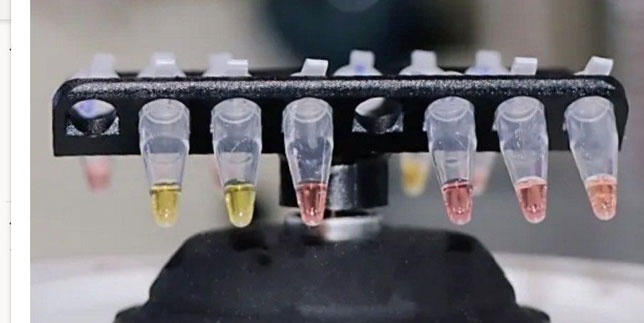Oxford Scientists Develop Rapid Testing Tech for COVID-19
- By Dian Schaffhauser
- 03/18/20

The test produced by Oxford researchers uses a color change to identity the presence of the coronavirus. A positive sample changes from pink to yellow. Each test uses three vials, each with different primers. A positive test would turn two vials yellow and leave one pink. This acts as a negative control to confirm that the test has worked. Source: the University of Oxford
Two research teams — one in Oxford and the other in Suzhou, China — have come up with a rapid-testing technology for coronavirus (COVID-19). The project is taking place at the University of Oxford and Oxford's Suzhou Centre for Advanced Research (OSCAR).
The advantages are that the test runs faster, doesn't need any kind of complicated instrument to process results and is highly sensitive. It produces fewer false positives and the results have been highly accurate. And while the current viral RNA tests take between one and a half and two hours to generate a result, the new test can produce a result in 30 minutes. All of that adds up to being able to identify patients earlier in the stages of infection, which in turn can help reduce the spread, the scientists reported.
The test is given by taking a swab from the back of the throat.
The technology requires a "simple heat-block" maintained at a constant temperature for RNA reverse transcription and DNA amplification. The results, according to the scientists, can be read by the naked eye, which makes it useful in locations outside of traditional testing labs. The Oxford scientists said they are now working to develop an integrated device so that the test can be used at clinics, airports or home.
The technology has been validated with clinical samples at Shenzhen Luohou People's Hospital in China. The hospital applied the rapid detection kits on 16 clinic samples, including eight positives and eight negatives, all of which had been previously confirmed by conventional RT-PCR methods and other clinical evidence. The test results using the rapid detection kits were all successful, the researchers noted.
The Oxford team is being jointly led by Wei Huang, director of the Synthetic Biology & Single Cell Raman Biotechnology Group and Zhanfeng Cui, professor of chemical engineering and director of the Oxford Centre for Tissue Engineering and Bioprocessing. Both groups are in the University of Oxford's Engineering Science Department.
Now the group is working to improve test capabilities. Zhanfeng said that the length of time it'll take to get the new test into the hands of healthcare practitioners and others "depends on our access to clinical samples. If we have access to sufficient samples, we can get this down in a couple of weeks." He noted that the hunt for clinical samples was on. Once the efficacy of the technology was confirmed, test kits — but not the integrated device — could roll out to professional test centers as quickly as two to four weeks, he added.
The project was initiated at OSCAR; the experiments to develop the technology were performed in Oxford's Department of Engineering Science.
The latest updates on COVID-19 research being done at Oxford facilities is on the university's website.
About the Author
Dian Schaffhauser is a former senior contributing editor for 1105 Media's education publications THE Journal, Campus Technology and Spaces4Learning.